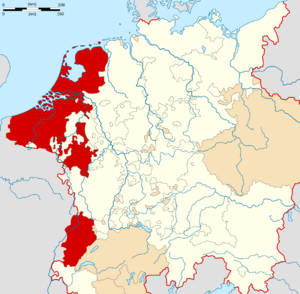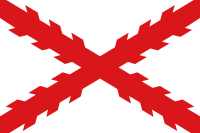Burgundian Circle facts for kids
Quick facts for kids Burgundian Circle
Burgundischer Kreis
|
|
|---|---|
|
|
| 1512–1797 | |
 The Burgundian Circle after 1548 within the Holy Roman Empire |
|
| Historical era | Early modern period |
|
• Established
|
1512 |
|
• Secession of the
Seven United Provinces |
1648 |
|
• Disestablished
|
1797 |
| Today part of | |
The Burgundian Circle (German: Burgundischer Kreis, Dutch: Bourgondische Kreits, French: Cercle de Bourgogne) was a special region within the Holy Roman Empire. It was created in 1512 and grew much larger in 1548. Think of an Imperial Circle as a group of states or territories that worked together for defense and to collect taxes for the Empire.
This circle mostly covered what we now call the Netherlands, Belgium, and Luxembourg. It also included parts of modern-day France and a region called the Free County of Burgundy. For most of its history, the lands of the Burgundian Circle were controlled by the Spanish branch of the House of Habsburg, a powerful European family.
Over time, the size of the Burgundian Circle changed a lot. In the 1600s, some parts, like the Seven United Provinces, broke away to become independent. This was officially recognized in 1648. Later, France took over the Free County of Burgundy in 1678. By the 1700s, the circle was mainly known as the Austrian Netherlands. Its existence ended in the 1790s when Revolutionary France took over its western territories.
Contents
What Was Inside the Circle?
| History of the Low Countries | ||||||||
|---|---|---|---|---|---|---|---|---|
| Frisii | Belgae | |||||||
| Cana- nefates |
Chamavi, Tubantes |
Gallia Belgica (55 BC – 5th c. AD) Germania Inferior (83 – 5th c.) |
||||||
| Salian Franks | Batavi | |||||||
| unpopulated (4th–5th c.) |
Saxons | Salian Franks (4th–5th c.) |
||||||
| Frisian Kingdom (6th c.–734) |
Frankish Kingdom (481–843)—Carolingian Empire (800–843) | |||||||
| Austrasia (511–687) | ||||||||
| Middle Francia (843–855) | West Francia (843–) |
|||||||
| Kingdom of Lotharingia (855– 959) Duchy of Lower Lorraine (959–) |
||||||||
| Frisia | ||||||||
Frisian Freedom (11–16th century) |
County of Holland (880–1432) |
Bishopric of Utrecht (695–1456) |
Duchy of Brabant (1183–1430) Duchy of Guelders (1046–1543) |
County of Flanders (862–1384) |
County of Hainaut (1071–1432) County of Namur (981–1421) |
P.-Bish. of Liège (980–1794) |
Duchy of Luxem- bourg (1059–1443) |
|
Burgundian Netherlands (1384–1482) |
||||||||
Habsburg Netherlands (1482–1795) (Seventeen Provinces after 1543) |
||||||||
Dutch Republic (1581–1795) |
Spanish Netherlands (1556–1714) |
|||||||
Austrian Netherlands (1714–1795) |
||||||||
United States of Belgium (1790) |
R. Liège (1789–'91) |
|||||||
Batavian Republic (1795–1806) Kingdom of Holland (1806–1810) |
associated with French First Republic (1795–1804) part of First French Empire (1804–1815) |
|||||||
Princip. of the Netherlands (1813–1815) |
||||||||
| United Kingdom of the Netherlands (1815–1830) | Gr D. L. (1815–) |
|||||||
Kingdom of the Netherlands (1839–) |
Kingdom of Belgium (1830–) |
|||||||
| Gr D. of Luxem- bourg (1890–) |
||||||||
After 1548, the Burgundian Circle was made up of many different areas. These included the famous Seventeen Provinces and the Free County of Burgundy.
The Seventeen Provinces
These were a group of territories in the Low Countries. Many of them later became part of the independent Dutch Republic.
- The Margraviate of Antwerp.
- The County of Artois: This area was given to France in 1659.
- The Duchy of Brabant.
- The County of Flanders.
- The Lordship of Frisia: This area joined the United Provinces starting in 1579.
- The Lordship of Groningen: This included the Ommelanden and the City of Groningen. It joined the United Provinces from 1579 to 1594.
- The Duchy of Guelders: Most of this area joined the United Provinces from 1579.
- The County of Hainaut.
- The County of Holland: This joined the United Provinces from 1579.
- The Duchy of Limburg: This was controlled by the Dukes of Brabant.
- The Duchy of Luxembourg.
- The Lordship of Mechelen: This was a special personal area of the Duke of Burgundy.
- The County of Namur.
- The Lordship of Overijssel: This included the County of Drenthe and joined the United Provinces from 1579.
- The Prince-Bishopric, later Lordship of Utrecht: This joined the United Provinces from 1579.
- The County of Zeeland: This was connected to Holland and joined the United Provinces from 1579.
- The County of Zutphen: This was connected to Guelders and joined the United Provinces from 1579.
The County of Burgundy
This part of the circle was separate from the Seventeen Provinces.
- The Free County of Burgundy.
- The Imperial City of Besançon.
Both of these were taken over by France in 1678.
A Brief History
The areas that became the Seventeen Provinces were once part of the Burgundian Netherlands. These lands were ruled by the Dukes of Burgundy, who were French nobles. Many of these lands were "fiefs" of the Holy Roman Empire. A fief was land granted by a lord in exchange for loyalty and service.
In 1363, the French King John II gave the Duchy of Burgundy to his youngest son, Philip the Bold. Philip married Margaret of Dampierre, who brought with her a huge dowry. This dowry included important lands like Flanders, Artois, and the Imperial County of Burgundy. This made Philip the start of the powerful House of Valois-Burgundy.
His grandson, Philip the Good, became Duke of Burgundy in 1419. He bought more lands, like Namur, and inherited others, like Brabant and Limburg. He also gained control of Hainaut, Holland, Zeeland, and Luxembourg. The Burgundian lands started to look like a large kingdom.
However, this growing power ended suddenly when Charles the Bold died in 1477. He had planned to marry his daughter, Mary of Burgundy, to Maximilian I of Austria, a prince from the House of Habsburg. Charles wanted his lands to become a new "Kingdom of Burgundy." But he died in battle before this could happen.
To protect her lands from the French king, Mary married Maximilian in the same year. Maximilian defeated the French army and, through the Treaty of Senlis in 1493, brought the Seventeen Provinces under Habsburg control. The Holy Roman Empire officially gained sovereignty over these lands in 1529.
Maximilian's grandson, Emperor Charles V, eventually united all seventeen provinces under his rule by 1543. In 1548, a special agreement moved these provinces into the Burgundian Circle. This meant the circle grew much larger and had to pay more taxes to the Empire. Another rule, the Pragmatic Sanction of 1549, said that the Seventeen Provinces should always stay united and be inherited by the same ruler.
When Charles V stepped down in 1556, his lands were split. His son, Philip II of Spain, received the Seventeen Provinces. During this time, a group called the States General of the Netherlands was formed to represent the people of these provinces.
But conflicts between Philip II and his Dutch subjects led to the Eighty Years' War in 1568. The seven northern provinces fought for and won their independence. They formed a new country called the Seven United Provinces. These were:
- Groningen and the Ommelanden
- Friesland
- Overijssel
- Guelders (most of it) and Zutphen
- Utrecht
- Holland
- Zeeland
The southern provinces, like Flanders, Brabant, and Luxembourg, remained under Spanish rule. They became known as the Spanish Netherlands. The war officially ended in 1648 with the Treaty of Westphalia, which recognized the independence of the Dutch Republic.
Over the 1600s, parts of Artois, Flanders, and Hainaut were given to France through various treaties. This further reduced the size of the Burgundian Circle.
See also
 In Spanish: Círculo de Borgoña para niños
In Spanish: Círculo de Borgoña para niños
- Seventeen Provinces
- Burgundian Netherlands
- Governors of the Habsburg Netherlands
- History of Burgundy
- Kingdom of Burgundy
- Middle Francia
- Spanish Road
- Blue Banana





